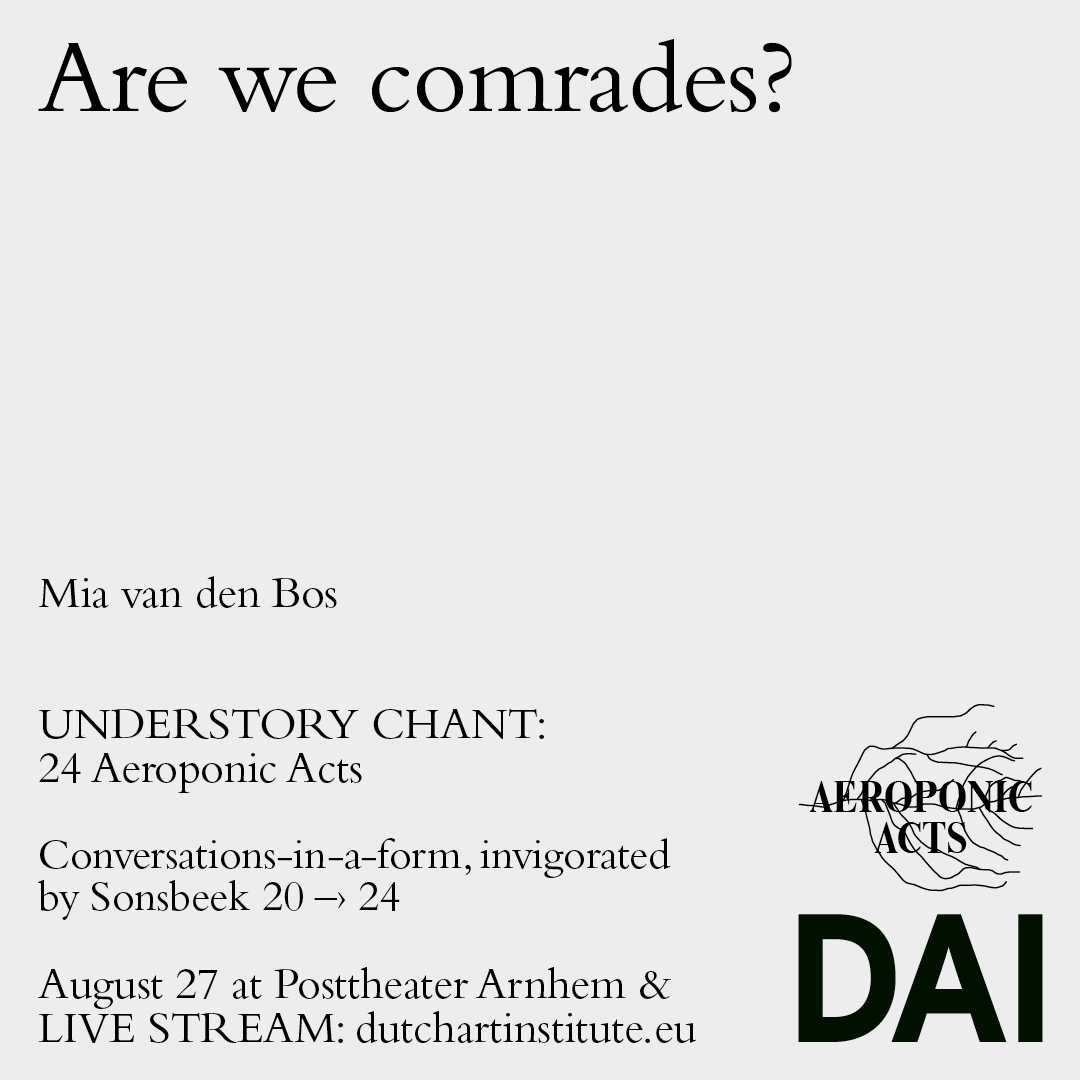Mia van den Bos: Reading toward a manifesto
‘Aeroponic’ – root systems nourished by air – Acts is the name given to the nomadic Dutch Art Institute’s final & festive iteration of the two year long so-called Kitchen* trajectory. Aeroponic Acts are conversations-in-a-form. Each presenter addresses one question as a practice of engagement.
Here you will find the documentation of Mia van den Bos' presentation as filmed by Baha Görkem Yalım, followed by a written report, authored by Harun Morrison, which includes a summary of the spoken comments by esteemed guest respondents Barby Asante, Lisette Lagnado and Momtaza Mehri.
Reading toward a manifesto
Mia's question: Are We Comrades?
Mia's introduction: Building on the final proposition of my thesis The Artist’s Social Union, this collective reading is an experiment in imagining the united political subjectivity of the artist as a member of the precarious class.
Cards designed by Raúl Silva (DAI,2021) and printed by Corine van der Wal at RisoWiso, Arnhem.
Harun's report: The audience were invited on stage, sat informally around a microphone and stand, to participate in a collective reading. A set of cards is numbered, and one by one different audience members stand to read the text. “Two. Do you know that the Paris Commune contained a significant artists’ faction among the revolutionaries? The manifesto of the Artist’s Federation was read aloud to a delegation of four hundred artists during the Commune. And ten thousand of those convicted after the defeat of the Paris Commune were artisan and design workers. Three. This example goes against the common idea that artists are too “individualistic” or “free-spirited” to organise collectively in an effective way. Maybe the concept of artists as individualistic is more a reflection of the ideal subjectivity of an artist within capitalist bourgeois culture — one who must constantly produce difference in order to compete in a winner-takes-all market-place — and not an inherent character of those who hone and value their own creative production.” Successive readers, with different voices, tones, inflections and accents embodied a collectivity that the texts sought. Additional packs, elegantly designed by Raul Silva, were tied with ribbons and distributed across the seating; emphasising their status as both text-as-object and an operator within a gift economy.
The cascade of propositions came more swiftly than could be processed in the moment, though hanging in the air long enough for new associations to form, until one’s mind is taken in another direction by another voice. The constant surge of texts generated a meditative interiority, despite the plurality of messengers.
Barby Asante: The first thing I want to draw on is reading together - and the meaning and action of reading together, what that means in terms of thinking together. I want to reference Grand Provisions, by Tonika Sealy Thompson and Stefano Harney, a theorisation of their reading camp as generative refuge. How that's a really important strategy together. Ground Provision is taken from Walter Rodney (who has a book called The Groundings With My Brothers). / I want to disrupt the notion of the working-class, we were able to see who was working in different ways, taking care of everyone else across the pandemic. We should remember certain words are precarious in themselves: ‘comrades’, ‘solidarity’.
Momtaza Mehri: I was thinking about the artist being a voice of the precariat and the social capital that comes with that. Materially you may be a member of the precariat but as an artist you can leverage the cultural capital that you embody. This reminds me of a 2011 work by Khaled Hourani: “A Manifesto Declaring Palestinian Refugees in Lebanon as a Art Community Until Proven Otherwise.” The title is in reference to Palestinian refugees living in Lebanon being prohibited from practicing more than seventy professions, except art. This raises interesting questions about the artist’s life, who gets to be an artist and when the role itself becomes a cage.
I can’t transcend certain situations as I’m still in them.
I’d also like to point you to a text ABOUT HATING ART by Asomodeus, that in turn points to resident led action against art-washing by the LA communities in Boyle Heights.
Lisette Lagnado: How to mend the gap between the representation of some ideas and the presentation of a manifesto? I was struck by the collective voice. With different accents, different bodies. The graphic presentation is beautiful. . . . but it doesn’t give a sense of the differences of classes, genders and so on. I wasn’t clear on the position of the manifesto, not that one should take it literally as a document of the precarious class. However what I like is how it raises different questions as a collective voice. I take the project as a work that chanllenges the boundary between artist and activist.
Mia van den Bos' "Reading toward a manifesto" was presented before live audience at the Posttheater in Arnhem on August 26th.
Find the overview of all 24 AEROPONIC ACTS 2021 here: UNDERSTORY CHANT

